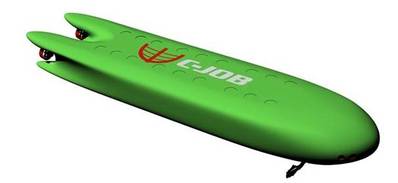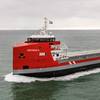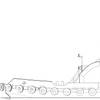Autonomous Underwater Dredger Unveiled
As autonomy gains a foothold in the maritime world, dredging appears next in line to transition to operations without direct human control.
A new design concept unveiled by a prominent Dutch ship design and engineering company aims to deliver major power savings and a larger working window for port maintenance dredging operations.
The Autonomous Underwater Maintenance Dredger (AUMD) design developed by C-Job Naval Architects is a completely submerged dredging vessel specifically created for maintenance in port environments.
According to C-Job, the one-of-a-kind fully electric design presents a more sustainable option when compared to conventional dredgers as it requires significantly less power. Equipped with a zero-emissions 16MWh battery pack, the dredger packs enough power for up to 12 hours of maintenance dredging in shallow waters. The design features fully redundant propulsion both in power supply as well as azimuthing- and bowthrusters.
A power/speed prediction comparison study with a conventional trailing suction hopper dredger showed that the AUMD requires 55% less propulsion power, said Rolph Hijdra, Autonomous Vessels Research Lead at C-Job. “And by submersing the vessel we could reduce the suction head cutting the dredge pump power demand by 80%.”
C-Job attributes the propulsion efficiency gains to mitigated wave-making and -breaking resistance, while improved dredging power demand is the result of the reduced suction head of the dredge pump (which is reduced from nearly 35 meters to 6 meters).
Submersion also increases operability as it mitigates wave motions as the vessel’s able to remain submerged throughout the dredging cycle. The AUMD only needs to surface for repair, maintenance and charging its batteries.
The hull shape allows for operations near the seabed with the flat bottom cross section, and the depth of the vessel is limited to only 8.5 meters which enables it to operate in shallow waters.
The AUMD features the same hopper volume as the traditional dredger even though the overall length of C-Job’s design has been reduced by 20%. And due to the fully buoyant hull, a higher payload over main dimension ratio is obtained.
Profit booster
Power efficiency and operability gains ultimately lead to greater profits, Hijdra said. “Autonomous shipping provides enormous potential for ship owners, with both technical design and economic benefits. According to our research, even with a conservative approach, we found that with the AUMD ship owners can expect nearly twice as much profit after 15 years.”
Hijdra said initial investment is higher, but lower operational costs make AUMD worth considering.
A protective propeller heel, for example, lessens the risk of squat and reduce early wear of the propellers due to sand inflow into the propellers, C-Job said.
As the hopper is supposed to be open to sea at all times, no sloshing effect is present which reduces the amount of trim/heel compensation significantly, easing operations. Still, several trim and heel compensating ballast tanks are envisioned in the design.
While C-Job's research and development department focused on reduced power demand, sustainability, and operability, the team also considered other aspects such as emergency access, which can be obtained through the diver’s lock. Data communication with the vessel was envisaged via shore-based communication networks such as 4G/5G.
Work remaining
Tim Vlaar, Technical Director at C-Job, said, “In order for autonomous vessels like the Autonomous Underwater Maintenance Dredger to become reality more work is needed and requires all stakeholders such as class, port authorities, autonomous technology companies and launching customers to come together.
“Of course, continued development of autonomous vessel designs is also needed to fully explore the possibilities autonomous shipping presents even further.”













